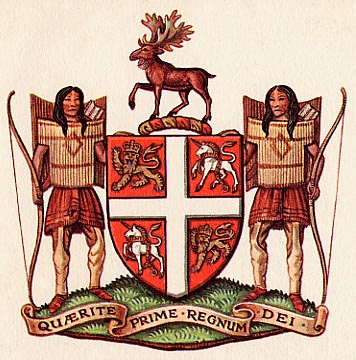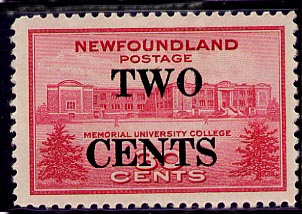
History

 |
Newfoundland History |
 |
Newfoundland Higher Education
(to 1949)
[This text was written in 1949. For the full citation, see the end of the document]
Previous to 1890 the highest examination taken in Newfoundland colleges (high schools) was the London matriculation. Only five students had passed, to that date, and there were not more than five teachers of first grade - the highest grade granted to teachers at that date - in all the outport schools. By 1915 the number of London matriculation graduates had gone into the scores and the first grades into hundreds. In this same year the Council instituted a senior associate grade, partly to meet requirements of Canadian universities, and at the same time the denominational colleges in St. John's became affiliated with the Maritime universities, and with Toronto, McGill, Harvard, and Columbia. By means of these affiliations Newfoundland students, provided they took the required courses and gained the required standing in their senior matriculation, might be permitted to begin the second-year courses on entering those universities.
A substantial advance towards the university level constituted the next step. In 1925 a junior college was organized in St. John's, known as the Memorial University College. One of the first Acts of the first provincial legislature in the July-August session of 1949 was to raise the status of the college to a degree-conferring institution.

Memorial University College c. 1948
Teacher-training dates from 1851, when Wesleyans formed the Newfoundland School Society and opened, in 1852, the Wesleyan Normal Day School in St. John's. For teachers of the Church of England schools there was available after 1855 the central school in St. John's, reorganized in that year as a teacher-training centre under Mr. J. W. Marriott. This institution continued until 1901. In 1858 the government grant of £750 for the training of teachers, and in 1874 the appointment of denominational inspectors, further promoted this important aspect of education. In 1910 a normal school was established in St. John's by the Church of England, under the principalship of Arthur Barnes, and continued for some years. Summer schools for teachers were held in St. John's at irregular intervals from 1917 onwards. In 1921 the first non-denominational normal school was initiated with S. P. Whiteway as principal. It was discontinued in 1932 because of the general economic dislocation affecting educational grants, and was reorganized in 1934 as a department of the Memorial University College . Summer schools in which both teachers and academic students may continue their professional training are now a regular annual feature of the College, and are well attended.
More recent movements within the larger educational scheme are the introduction of kindergarten, adult education including visual education, and vocational education. The Kindergarten School was introduced by a lady teacher from Truro Normal School in 1894, and the first manual training school was opened in St. John's by a teacher from the same school in 1903. These branches of education are functioning today in St. John's, and in a few other centres. The adult education movement dates from 1929; Dr. Albert Mansbridge visited Newfoundland under the authority of the department of education, and as a result of his visit the Adult Education Association was then formed. Visual education, yet in its infancy, is associated with adult education, and while many settlements are visited by Film Board units, progress here is slow because of geographical difficulties. Vocational training had its beginning with ex-service men after World War I, and continued for two or three years. After World War II, the Vocational Institute in St. John's was set up again in the interests of ex-service men, and appears to be developing into a permanent vocational school. A northern outpost of education deserves at least passing mention: the achievements of the institutions initiated by Dr. Wilfred Grenfell in arts, crafts, manual training, gardening, cattle and hog raising, and much else, carried on at St. Anthony in northern Newfoundland, for the past forty years, are unique.
From time to time education in Newfoundland has taken stock of itself deliberately towards effecting desirable change. In the summer of 1933 one of the last Acts of the then responsible government was to invite C. A. Richardson, inspector for Lancastershire, England, to come to St. John's and make an investigation of the system of education. He reported his findings and made his recommendations on October 18, 1933, in Certain aspects of the educational system of Newfoundland . It was his opinion that Newfoundland education centred in its examination system rather than in the individual child and he outlined a workable, individualized, more freely expressive curriculum.
On the same date that Mr. Richardson's report was issued, the governor-in-council appointed principals of St. John's high schools, along with other educators and laymen "to consider the present curriculum of the public schools in Newfoundland and to make recommendations in connection therewith."
The committee held sixty-four meetings during seven months and reported on May 19, 1934, in The report of the commission of enquiry into the present curriculum of the colleges and schools in Newfoundland . The report advocated eliminating examinations in grades six to ten inclusive, and following the lines of the then newly issued curriculum of Nova Scotia . This policy has since been pursued, and a board of examiners common to Newfoundland and Nova Scotia sets and marks the papers of grades eleven and twelve.
Much has been written concerning education in Newfoundland . The histories of D. W. Prowse [See his History of Newfoundland], M. F. Howley, L. A. Anspach, and others, deal with various aspects of the subject. Material of primary importance may be found in the annual reports of the Newfoundland Department of Education, Council of Higher Education, and Memorial University College . Additional information may be found in G. Bolt, The Codner centenary (c. 1923); Newfoundland and British North American Soc., Proceedings (23rd report, London, 1846); Benevolent Irish Society, Centenary volume (Cork, c. 1906); V. P. Burke, Education in Newfoundland in J R. Smallwood (ed.), Book of Newfoundland (St. John's, 1937); W. F. Grenfell, Forty years for Labrador (Boston, c. 1910) and A Labrador doctor (London, 1924); T. Lodge, Dictatorship in Newfoundland (London, 1939); C. M. Coleman, School in Newfoundland (Empire Rev., 1941); Canada and Newfoundland education association, Trends in education, 1944, a survey ; R. A. MacKay (ed.), Newfoundland: economic, diplomatic, and strategic studies (Toronto, 1946); G. A. Frecker, Education in Newfoundland (Atlantic Guardian, 1945).
Source: Solomon P. WHITEWAY, "Education", in W. Stewart WALLACE, The Encyclopedia of Canada. Newfoundland Supplement , Toronto, University Associates of Canada, 1949, 104p., pp., 21-22.
© 2004 Claude Bélanger, Marianopolis College |